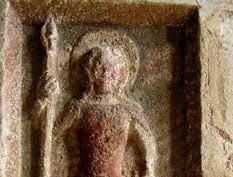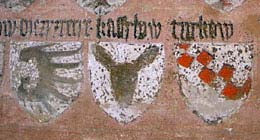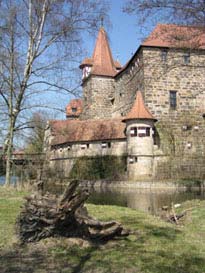|
|
 |
 |
 |
|
 Lauf an der Pegnitz Lauf an der Pegnitz
Wenzel Castle |
|
Favourably situated on the old trade route from Nuernberg to Bohemia and on the banks of the River Pegnitz, Lauf has developed to one of the most important and largest towns in the county of Nuernberg.
Just a hamlet in the second half of the 11th century, it became a busy trading post with a town hall in the centre of its marketplace. One early chronicler mentions four mills along the river in 1275, which together with the settlement were protected by the castle on the Pegnitz island.
|
|
 |
|
|
|
 |
|
The castle was the residence of vassals of the emperor who had to administer the imperial property. Lauf began to flourish under the rule of the medieval Emperor Karl IV and became an important stronghold between 1353 and 1373. Not only did he confirm the freedom of the city by documents but also established his own mint there.
The island castle, called Wenzel castle, was finished in 1360 and reflects royal fame and glory of the Middle Ages. In the imperial hall of the castle are more than one hundred coats of arms of the Bohemian noble families on display. The emperor had them carved into the smooth sandstone by skilled stonemasons.
Belonging to the Bavarian Kingdom since 1806, Lauf became the seat of various offices and courts. The flourishing industry, favoured by two railroad lines, attracted a lot of workers from Upper Palatinate and the Bohemian Forest regions.
|
|
|
|
|
|
|
|

|
|
|
|
Local History of Lauf an der Pegnitz |
|
In 1353 the Bohemian and German King Karl IV acquired several areas in today's Upper Palatinate and eastern Franconia. At last Lauf passed into possession of the Bohemian Kingdom in 1355.
In the year 1355 Lauf received municipal law and the right to mint coins. In the following years Lauf became an important mint and a busy city. In the years of the Bohemian regency (1353–1373) was the heyday of the city in the Middle Ages.
In the so-called Margrave’s War (1553) Lauf was almost completely destroyed.
|
|







